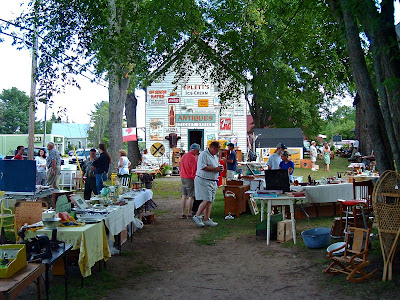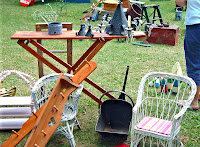
Summer. The Brigantine
Playfair at Parry Sound. Cap'n Weed, if you please, har harr. If'n the
Black Pearl be lost at sea, there's a berth or twenty down below, for the likes of your wee teens, wantin' adventure on Georgian Bay. It's the real deal. Toronto Brigantine runs two training ships for high school kids, who'd rather pass on the video arcades and shopping malls for a week or two. For about a $100 a day, all inclusive, you might talk your kids into a working vacation, where they can learn to rig and sail a Brigantine, cook in the cubbyhole galley, and barbecue on a deserted island beach. And meet some other kids

. It's character building says our Captain Weed, seconded by his First Mate, Jojo, and it works. It's turned around bored and troubled kids, and polished the rest with a sense of accomplishment, fostering in some a life long passion for sailing. The professional crew of nine, are all alumni of the program, regulars that kept coming back for years, and now training a new batch of kids, 16 on this 11 day leg out from Parry Sound to Midland. The
Playfair is a happy ship. Rare for any kid to go home unhappy, even if he or she (it's co-ed) didn't really want to go in the first place. As a registered charity, Toronto Brigantine is doing this for love, not money. Costs are further kept down by sponsors, alumni and volunteers who donate equipment, supplies, and time for maintenance, when their ships winter over in Toronto. Bursaries for some students, are available too. And what's it like? I wandered around on deck and below, talking to the kids and crew. No complaints. But it is so cramped below deck, sardines might be more

comfortable in a can. The mess is really on deck. The galley would fit into your hall closet, berths stacked 3 high, upholstered but hard and narrow. The
Playfair was built in 1972, In Kingston, Ontario. It's a Brigantine, a pirate ship in miniature, designed to be maneuvered by a young crew, with a sleek hull, sleeker than than her older cousins, and steel, for easier maintenance and without the timbers creaking and leaking. There's a diesel engine, not much used, but available for dead calms and tricky navigation through narrow or shallow channels and locks. Georgian Bay is mostly where she sails. It's the 30,000 Islands and the rugged coastline that makes her feel at home. Though she sails to and from Georgian Bay, via Lake Huron, Lake Erie and Lake Ontario, occasionally venturing to join other tall ships at the festival in Halifax. She might go out more on the high seas, but there are maintenance issues with salt water. Strolling on the big dock to stretch his legs, the Captain pauses by one of the big yachts berthed nearby, wondering what all the fuss is all about. A quarter million dollars for a car on water, with baby buggy plastic canopies. "Usually poorly constructed. You wonder why

they're doing this? The Playfair is overbuilt, so we can push her hard." Of course if you're retired and you've got the dough, you can't push yourself that hard either, though there are plenty of small sailboats that would give you the feel of sailing without the hard work, and the need for deckhands, say your grown-up kids who probably wouldn't show up unless the destination was some Club Med in the Caribbean. But if you feel the urge for more than an adventure out of a DVD box, sailing is still one of the things you can do, even on a budget. It's making a comeback if you read the yachting magazines.

There's skill, of course, even with all the modern navigational aids. And any trip can have an unpredictable factor, usually the weather, that can catch you off guard, like in Lake Erie, a hassle for weekend boaters who have to be at work Monday. Last year Labour Day, says Captain Weed, she was going through the west channel of Lake Erie, very shallow, only 12 feet deep. With shallow water, waves can get whipped up high, and there was a whopping storm. We were stranded for 3 or 4 days. When the coast guard came to check on us, you know these fully enclosed rescue craft, they radioed back, they were turning back. Not going out in that gale, since we didn't really need them. Of course they would have risked it, if we were in trouble. Otherwise the sailing is great,

the best there is in inland waters right around here, all through Georgian Bay. Might be a half million islands. Depends what you call an island. We get a chance to explore some with our students. We've got two big dories for that, plus inflatable lifeboats packed in big drums, if we have to abandon ship. Overcapacity too, it's safety first. Though we let the kids do just about anything you can do onboard, including handling the wheel. Mind you the crew supervises everything closely, so they don't make mistakes or get into trouble. Most of the time we're on the water, only going into port for supplies. So the kids share in the watches 24 hours a day. We hug the shore or sail right across the bay. On this leg we'll be going up to Manitoulin Island, before heading south for Midland. It's a great experience for everyone, the crew and the kids. If you're not a kid anymore, Brigantine does allow for charters and alumni sailings, so you could join them. See
http://www.tallshipadventures.on.ca/ 2010 Update
2010 UpdateFor more great pictures of the Playfair sailing, see
Yvonne Berg's Tall Ship Adventure.
Climb aboard the Playfair and the Pathfinder in Toronto for the
Toronto Waterfront Festival, June 30-July 4, 2010.
Sail training 4 hour cruises for groups up to 20 will be available for charter during the Festival from Toronto Brigantine, a not for profit registered charity.
Playfair and Pathfinder 2010 Summer Schedule. Book your kids (13-18) a berth on one to two week sailings through the Great Lakes, part of the
Great Lakes United Tall Ships Challenge.
Follow Toronto Brigantine's Playfair and Pathfinder
Tall Ship Adventures on Facebook.
Become a Member of Toronto Brigantine and help support 48 years of service to kids.







